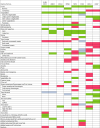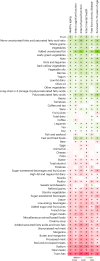Optimal dietary patterns for healthy aging
- PMID: 40128348
- PMCID: PMC12092270
- DOI: 10.1038/s41591-025-03570-5
Optimal dietary patterns for healthy aging
Abstract
As the global population ages, it is critical to identify diets that, beyond preventing noncommunicable diseases, optimally promote healthy aging. Here, using longitudinal questionnaire data from the Nurses' Health Study (1986-2016) and the Health Professionals Follow-Up Study (1986-2016), we examined the association of long-term adherence to eight dietary patterns and ultraprocessed food consumption with healthy aging, as assessed according to measures of cognitive, physical and mental health, as well as living to 70 years of age free of chronic diseases. After up to 30 years of follow-up, 9,771 (9.3%) of 105,015 participants (66% women, mean age = 53 years (s.d. = 8)) achieved healthy aging. For each dietary pattern, higher adherence was associated with greater odds of healthy aging and its domains. The odds ratios for the highest quintile versus the lowest ranged from 1.45 (95% confidence interval (CI) = 1.35-1.57; healthful plant-based diet) to 1.86 (95% CI = 1.71-2.01; Alternative Healthy Eating Index). When the age threshold for healthy aging was shifted to 75 years, the Alternative Healthy Eating Index diet showed the strongest association with healthy aging, with an odds ratio of 2.24 (95% CI = 2.01-2.50). Higher intakes of fruits, vegetables, whole grains, unsaturated fats, nuts, legumes and low-fat dairy products were linked to greater odds of healthy aging, whereas higher intakes of trans fats, sodium, sugary beverages and red or processed meats (or both) were inversely associated. Our findings suggest that dietary patterns rich in plant-based foods, with moderate inclusion of healthy animal-based foods, may enhance overall healthy aging, guiding future dietary guidelines.
© 2025. The Author(s).
Conflict of interest statement
Competing interests: M.G.-F. is the principal investigator of a grant funded by the International Nut Council. The other authors declare no competing interests.
Figures






References
-
- Centers for Disease Control and Prevention. Healthy Aging at a Glance, 2015: Helping People to Live Long and Productive Lives and Enjoy a Good Quality of Lifehttps://stacks.cdc.gov/view/cdc/43961 (National Center for Chronic Disease Prevention and Health Promotion (U.S.) & Division of Adult and Community Health, 2015).
-
- Office of Disease Prevention and Health Promotion. Healthy Aginghttps://health.gov/our-work/national-health-initiatives/healthy-aging#:~... (OASH, 2023).
MeSH terms
Grants and funding
- R00 DK122128/DK/NIDDK NIH HHS/United States
- P01 CA087969/CA/NCI NIH HHS/United States
- R01 AG087356/AG/NIA NIH HHS/United States
- P01 CA87969/U.S. Department of Health & Human Services | National Institutes of Health (NIH)
- K12 TR004384/TR/NCATS NIH HHS/United States
- U01 CA167552/CA/NCI NIH HHS/United States
- NNF23SA0084103/Novo Nordisk Fonden (Novo Nordisk Foundation)
- R01 HL35464/U.S. Department of Health & Human Services | National Institutes of Health (NIH)
- R01 HL034594/HL/NHLBI NIH HHS/United States
- UM1 CA186107/CA/NCI NIH HHS/United States
- R01 HL035464/HL/NHLBI NIH HHS/United States
- R01 HL088521/HL/NHLBI NIH HHS/United States
LinkOut - more resources
Full Text Sources
Medical
Research Materials

